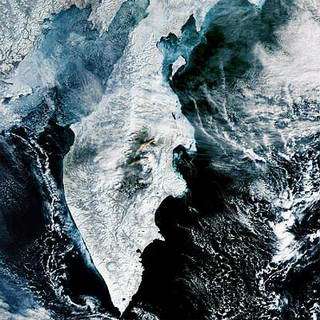Double volcanic eruption in Eastern Russia

Acquired from orbit 800 kilometres away, this Envisat image shows two volcanoes erupting simultaneously on Russia's snowy Kamchatka Peninsula this week.
Located in the Russian Far East, the Kamchatka Peninsula is a landscape covered with volcanoes, part of the Pacific 'Ring of Fire'. Two stratovolcanoes, Kliuchevskoi and Shiveluch are currently erupting simultaneously.
Image: This 7 March 2005 Envisat MERIS image shows the unusual phenomenon of the simultaneous eruption of two stratovolcanoes, Kliuchevskoi and Shiveluch (or Sheveluch) on Russia's Kamchatka Peninsula. Stratovolcanoes are formed of alternating layers of pyroclastic materials and subordinate lavas. They have conical shapes and are built up by multiple eruptions. The lava produced during stratovolcano eruptions is typically andesitic, with fine grains and dark colour. Andesitic eruptions tend to be explosive, producing pyroclastic materials and in some cases 'ignimbrites' - fist-sized pumice fragments. The Reduced Resolution mode image has a 300 metre resolution. Credits: ESA
The more southerly 4835-metre-high Kliuchevskoi volcano began its latest eruption on 17 January 2005. By 7 March its consequent lava flow had reached the Erman glacier and started to melt it, causing a threat of potential mudslides. The hot volcanic material in contact with the surrounding ice and snow caused secondary explosions, hurling material as far as eight kilometres into the air.
Above it is Kamchatka's most northerly active volcano Shiveluch – also known as Sheveluch. It is 3283 metres high and started its latest eruption on 27 February 2005. The erupting material covers an area over 700 kilometres across with a layer of ash about 150 kilometres wide and eight centimetres thick, extending westward to the Okhotsk Sea. A ten-km-wide lava flow destroyed the Shiveluch seismological station, located about eight km from the volcano.
Russia's Novosti RIA news agency reports that the village of Klyuchi located between the two volcanoes is suffering periodic ash falls but is otherwise safe. Aviation is at greater threat, with volcanic ash particles capable of disabling aircraft engines: Kamchatka is on a major airline route, and aircraft have had to divert around eruptions in the past.
The image was acquired by Envisat's Medium Resolution Imaging Spectrometer (MERIS) in Reduced Resolution Mode, with a spatial resolution of 300 metres and a width of 1284 km. It was processed for ESA by Brockmann Consult.
Source: ESA

















